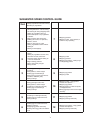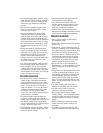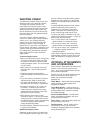10
• Using too much liquid, or baking on a
humid day, can cause your bread to fall or
wrinkle on top.
CAKE BAKING
• Have all ingredients and mixing bowls at
room temperature (BUT when preparing
whipped cream as a topping, bowl, chef’s
whisk, and cream should be refrigerator-
cold). Room temperature ingredients
incorporate and blend more easily.
• Fill pans immediately after mixing.
• Bake immediately after filling pans.
• Check for doneness at the beginning of
the time range given.
• Cool cakes completely on a wire rack
after baking.
• Using an offset spatula will make
spreading frosting easier.
Egg Whites
Egg whites at room temperature are best
for whipping. Bring to temperature safely
by placing eggs in a bowl of warm water for
10 to 15 minutes.
Add a small amount of acid such as cream
of tartar, lemon juice or vinegar when
whipping egg whites to stabilize them and
allow them to reach their optimum volume
and stiffness. Use
1
⁄
8
teaspoon cream of
tartar per large egg white – or 1 teaspoon
cream of tartar per cup of egg whites (8 to
10 large).
The time required to whip egg whites
will vary with the temperature of the
egg whites, age of egg whites, and
temperature/humidity of the kitchen. Keep
a close watch while whipping egg whites.
In humid or damp weather, you may not get
the volume of whipped egg whites that you
do in drier, warmer weather.
Place the room temperature egg whites
in the clean, dry mixing bowl. Attach the
clean, dry chef’s whisk. Start whipping the
egg whites and gradually increase to speed
6 until foamy, and then gradually increase
to speed 12. If egg whites are beaten too
rapidly in the beginning, their structure
will not be as stable and strong, and they
will not reach the volume that they should
when completely beaten. Over-beaten
egg whites will also separate or weep in a
meringue topping.
Timing when adding sugar to egg whites
is important. If adding less than ¼ cup (4
tablespoons), add it in the beginning at the
raw white stage. For larger amounts, add
sugar slowly and gradually to the whipped
egg whites after they reach soft peak
stage. Always add sugar in a slow steady
stream while egg whites are being whipped
– do not add sugar directly to the center
of the bowl on top of beaten egg whites;
doing this may cause them to deflate.
When whipping egg whites, they will at
first appear foamy or frothy. Then they
will become stiffer and start to hold their
shape. Next, soft peaks will form – this is
when the tips of the peaks fall when the
whisk is lifted up – soft peaks are often
required for mousses or soufflés. The next
stage is almost stiff to stiff peaks. This is
used for recipes such as meringues – the
whites will appear dry, the peaks will hold
their shape, and the whites will be shiny.
The final stage is stiff and dry. The whites
will not be uniformly white, but will appear
speckled, and they will no longer be shiny
in appearance.
Beaten egg whites should be used
immediately after beating them. If they wait
for longer than 5 minutes, they will begin to
deflate and lose volume and structure. Egg
whites beaten with sugar or cream of tartar
are more stable and will last a little longer.
Sanitizing Egg Whites
Take care when adding raw egg whites to
recipes that are not cooked or baked as
there is a chance they may carry harm-
ful bacteria. If you have a recipe that calls
for raw egg whites, you may wish to use
powdered egg whites or “sanitize” the egg
whites by doing the following: Place the
egg whites, 2 tablespoons of the granulat-
ed sugar from your recipe, 2 tablespoons
water, and a pinch of cream of tartar in
the Cuisinart
™
mixing bowl and stir until
smooth. Place over the pan of simmering
water and stir constantly with a spotlessly
clean rubber spatula until the mixture
registers 160°F on an instant-read ther-
mometer – start checking the temperature
after about a minute of stirring. When the
egg white mixture registers 160°F, dry off
the bottom of the bowl and place on the
Cuisinart
™
stand mixer. Insert the chef’s
whisk. Continue as directed in your recipe.














